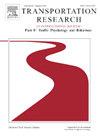Exploring the safety effect of traffic guidance sign alignment at expressway hybrid toll plazas
IF 3.5
2区 工程技术
Q1 PSYCHOLOGY, APPLIED
Transportation Research Part F-Traffic Psychology and Behaviour
Pub Date : 2025-02-26
DOI:10.1016/j.trf.2025.02.013
引用次数: 0
Abstract
With the rapid growth in automobile ownership and thus highway usage demand, toll plaza congestion has become a major issue that limits the efficiency of expressway traffic. To optimize signage facilities and improve the performance and safety of toll plaza operations, the mechanisms that influence driver behaviors in expressway toll plaza areas were analyzed through simulation experiments in this paper. The simulations replicated the lane configuration and signage layout of the Jinan Ganggou Toll Plaza and Jinan North Toll Plaza in China. Four experimental scenarios and four signage schemes were designed and evaluated under 16 Experimental Designs per driver, culminating in a total of 100 samples. During the simulations, vehicle driving state parameters were collected, and multivariate analysis of variance and generalized estimating equation were used to examine the effects of different factors, including vehicle type, queue length at toll lanes, and signage schemes, on driver behavior in the toll plaza area. Finally, an in-depth analysis was conducted on subjective questionnaire data provided by drivers to assess thoroughly the mechanisms behind driving behavior and the integration of traffic guidance signage schemes in toll plazas. Results indicate that through driving simulation and driver questionnaires, the experimental variables of vehicle type and queue length significantly affect lateral offset, vehicle operating speed, and maximum deceleration. Furthermore, signage scheme 4 provides effective guidance to drivers, improves traffic efficiency, alleviates congestion in toll lanes, enhances toll lane utilization, and offers higher levels of safety and comfort.
探索高速公路混合收费广场交通引导标志对齐的安全效果
随着汽车保有量和高速公路使用需求的快速增长,收费广场拥堵已成为制约高速公路交通效率的主要问题。为了优化收费广场的标志设施,提高收费广场运营的性能和安全性,本文通过仿真实验分析了高速公路收费广场区域驾驶员行为的影响机制。模拟模拟了中国济南港沟收费广场和济南北收费广场的车道配置和指示牌布局。在每个驾驶员16个实验设计下,设计了4个实验场景和4个标识方案,最终共100个样本。在模拟过程中,收集车辆行驶状态参数,采用多元方差分析和广义估计方程,考察了收费广场区域内车辆类型、收费车道排队长度和标志方案等不同因素对驾驶员行为的影响。最后,对驾驶员提供的主观问卷数据进行深入分析,以全面评估收费广场驾驶行为和交通引导标志方案整合的机制。结果表明,通过驾驶模拟和驾驶员问卷调查,车辆类型和排队长度这两个实验变量对横向偏移量、车辆运行速度和最大减速度有显著影响。此外,标识方案4对驾驶员进行了有效的引导,提高了交通效率,缓解了收费车道的拥堵,提高了收费车道的利用率,并提供了更高的安全性和舒适性。
本文章由计算机程序翻译,如有差异,请以英文原文为准。
求助全文
约1分钟内获得全文
求助全文
来源期刊
CiteScore
7.60
自引率
14.60%
发文量
239
审稿时长
71 days
期刊介绍:
Transportation Research Part F: Traffic Psychology and Behaviour focuses on the behavioural and psychological aspects of traffic and transport. The aim of the journal is to enhance theory development, improve the quality of empirical studies and to stimulate the application of research findings in practice. TRF provides a focus and a means of communication for the considerable amount of research activities that are now being carried out in this field. The journal provides a forum for transportation researchers, psychologists, ergonomists, engineers and policy-makers with an interest in traffic and transport psychology.

 求助内容:
求助内容: 应助结果提醒方式:
应助结果提醒方式:


